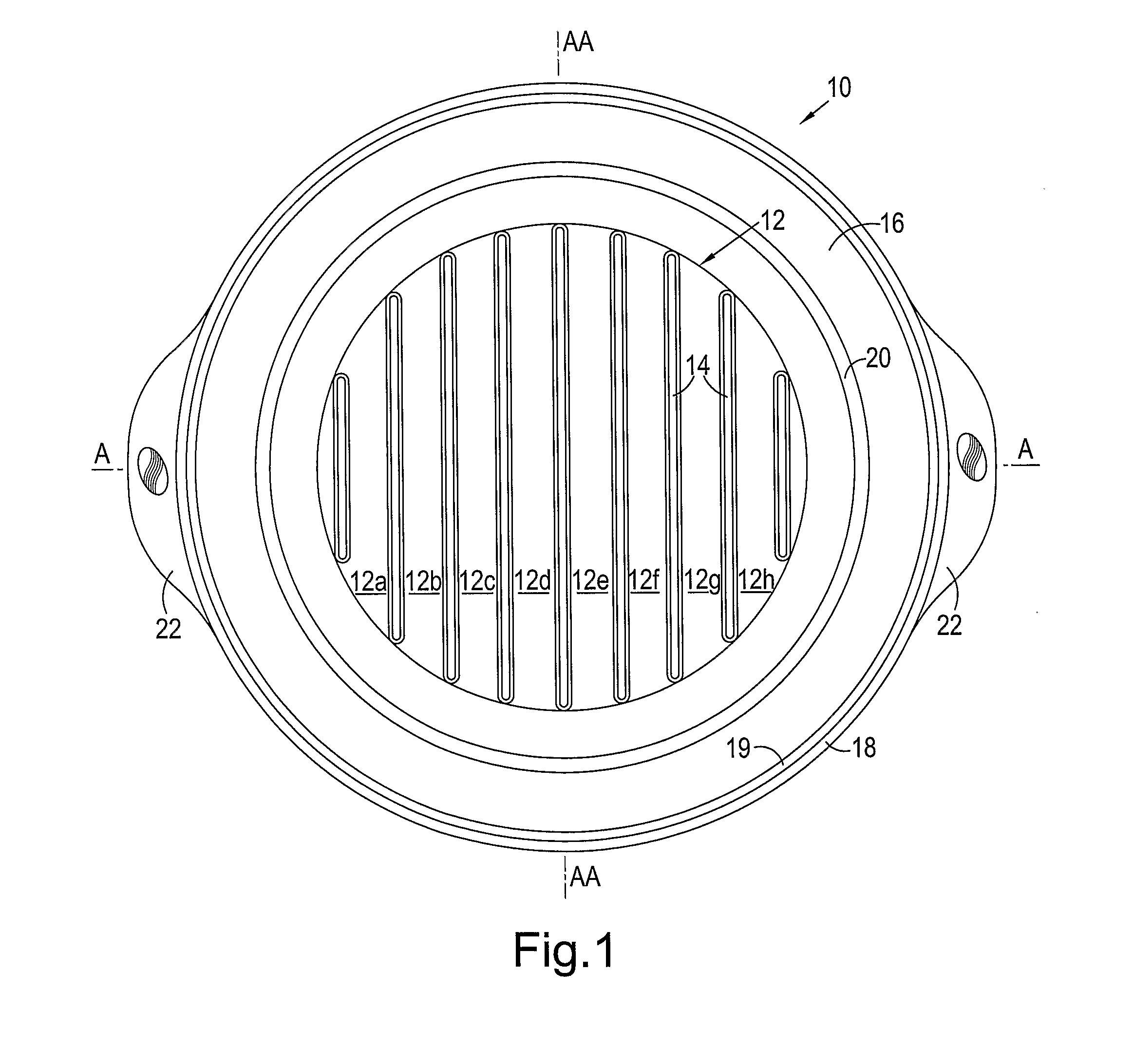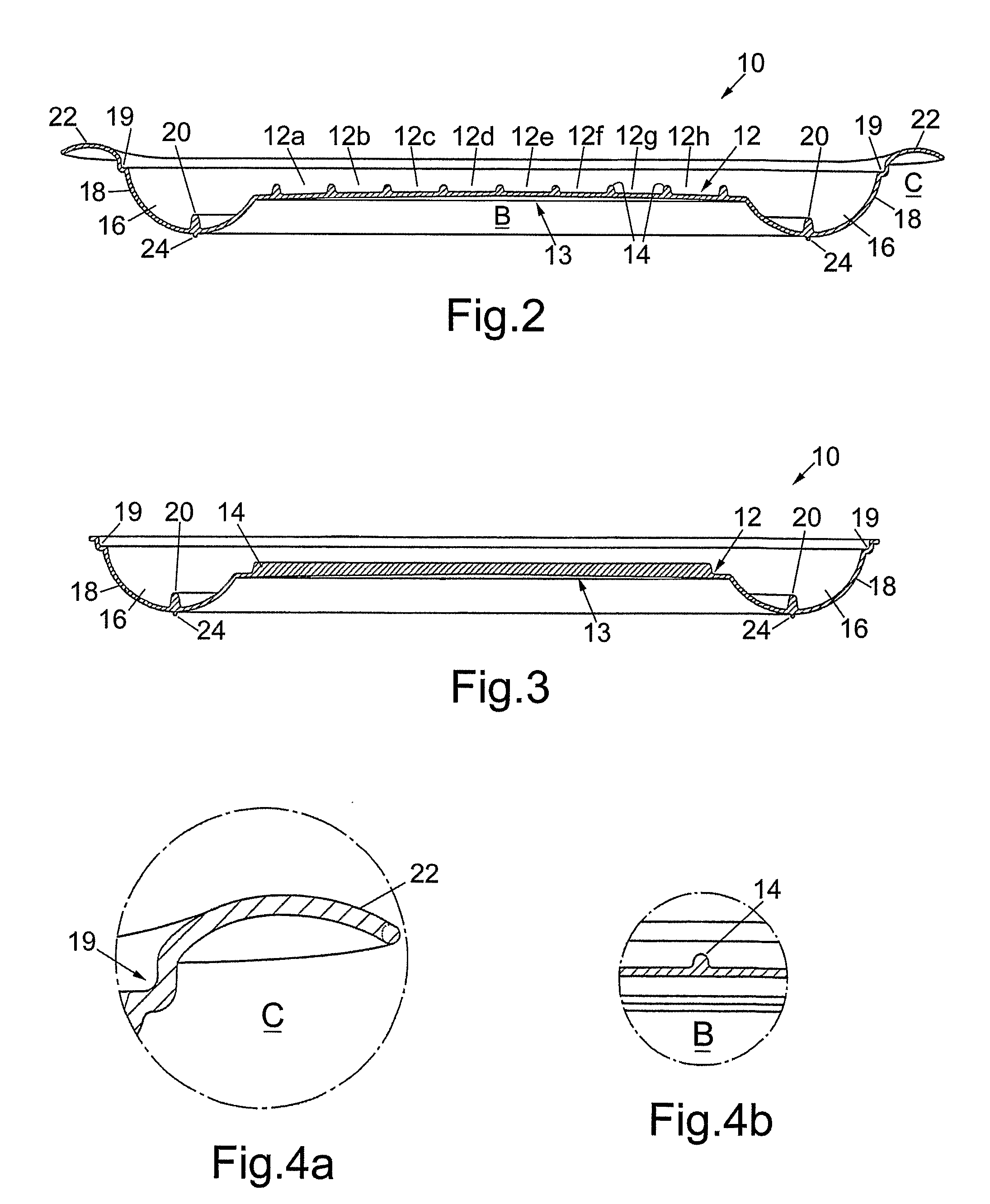Cookware
- Summary
- Abstract
- Description
- Claims
- Application Information
AI Technical Summary
Benefits of technology
Problems solved by technology
Method used
Image
Examples
embodiment 1
A Roasting Dish
[0052]A first embodiment of the invention, as shown in FIGS. 1, 2, 3, 4a, 4b and 5, is a roasting dish 10 which may be used for cooking high fat products such as meats. The roasting dish 10 has a first region 12 in the centre of the upper surface of the dish, which incorporates a plurality of upward protrusions 14, in this example having the form of parallel ridges or ribs extending continuously from substantially one side of the central region 12 to the other. As shown in FIG. 2, the uppermost regions of the ridges 14 extend upwards to a common height, thereby (in combination) forming a substantially coplanar surface (which may be considered as an imaginary plane) on which a food product may be placed for cooking.
[0053]Other configurations of protrusions, ridges or ribs 14 are possible. For example, discrete protrusions (e.g. circular in cross-section) may be used. Alternatively, semi-continuous ridges may be used (i.e. lines of elongate ridges separated by gaps with...
embodiment 2
A Cooking Plate (With Handles)
[0065]A second embodiment of the invention, as shown in FIGS. 6, 7, 8, 9a, 9b and 10, is a cooking plate 30, suitable for cooking foods such as fish or vegetables. The plate 30 has a cooking region 32 in the centre of the upper surface of the plate, which incorporates a plurality of continuous parallel ridges 34. As shown in FIG. 7, the uppermost regions of the ridges 34 extend upwards to a common height, thereby (in combination) forming a substantially coplanar surface on which a food product may be placed for cooking. As with the roasting dish 10 described previously, the ridges 34 need not be parallel or continuous (when seen in plan view), and other arrangements are possible.
[0066]The central region 32 of the upper surface is inclined (in this case, arced in a curved or convex configuration) relative to the common height of the tops of the ridges 34. The undersurface 33 is also similarly arced, such that its profile is approximately parallel to that...
embodiment 3
A Cooking Plate (Without Handles)
[0070]A third embodiment of the invention, as shown in FIGS. 11, 12, 13, 14a, 14b and 15, is another cooking plate 50, in this case not having handles. The plate 50 has a cooking region 52 in the centre of the upper surface of the plate, which incorporates a plurality of continuous parallel ridges 54. As shown in FIG. 12, the uppermost regions of the ridges 54 extend upwards to a common height, thereby (in combination) forming a substantially coplanar surface on which a food product may be placed for cooking. As with the embodiments described previously, the ridges 54 need not be parallel or continuous, and other arrangements are possible.
[0071]The central region 52 of the upper surface is inclined (in this case, arced in a curved or convex configuration) relative to the common height of the tops of the ridges 54. The undersurface 53 is also similarly arced, such that its profile is approximately parallel to that of the upper surface.
[0072]A gutter 5...
PUM
 Login to View More
Login to View More Abstract
Description
Claims
Application Information
 Login to View More
Login to View More - R&D
- Intellectual Property
- Life Sciences
- Materials
- Tech Scout
- Unparalleled Data Quality
- Higher Quality Content
- 60% Fewer Hallucinations
Browse by: Latest US Patents, China's latest patents, Technical Efficacy Thesaurus, Application Domain, Technology Topic, Popular Technical Reports.
© 2025 PatSnap. All rights reserved.Legal|Privacy policy|Modern Slavery Act Transparency Statement|Sitemap|About US| Contact US: help@patsnap.com



